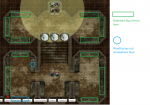Here is a high level encounter I participated in as a player, which illustrates SilverFireSage's points in his original post.
The encounter:

Party:
1. Level 17 Half Orc Battlemaster Fighter (strength based), known as Decado.
2. Level 17 High Elf Abjurer Wizard, known as Morindin.
3. Level 17 Wood Elf Fighter (Champion )11/Sorcerer 6 (ranged based), known as Argon (not to be confused with Aragon).
4. Level 17 Dwarven War Cleric, known as Druss.
The Fighter/Sorc archer had foresight on him, which is an extremely potent combination with sharpshooter. Foresight used in this way is probably the most damaging spell in the game by far.
Opponents (note my CR's here are approximations, I cannot remember exactly):
1 Vampire (Spell caster variant). CR15
1 Vampire Spawn. CR5
3 Winter Wolves. CR3
16 Skeleton's (spawned later in combat). CR1/4
1 Wraith (spawned later in combat). CR5
The fight started in a crypt with the PC's heading down a narrow stairway into the tomb. The vampire, vampire spawn, and winter wolves were visible as the party came down the stairs. It went (roughly) like this:
1. Wizard gets a wall of force (5) off around the vampire and vampire spawn.
2. Winter Wolves run up to the party and blast them with their icey breath, doing a fair amount of damage. The party is stuck in the entrance with no way forward.
3. Cleric casts etherealness (8) on everyone except the Wizard
4. Wizard casts blink (3) and goes to the ethereal plane
5. Wolves fall back since they have no targets, vampires shake fists from within wall of force.
6. Cleric casts bless (1) on ethereal party members (excluding the Wizard) and they surround the wolves. Archer casts Haste (3) on himself.
7. Wizard blinks back into the tomb, out of sight from the wolves around a corner.
8. Cleric dismisses etherealness, party attacks wolves.
9. Wolves are dispatched.
10. Vampires do more fist shaking.
11. Skeletons burst out of tombs lining the walls of the crypt, about 16 of them. 4 are looking at the Wizard, 4 are looking at the Archer, 4 at the Cleric, and 4 at the Fighter.
12. The Fighter takes some damage, Wizard has his arcane ward, Archer has foresight and haste so he is impossible to hit, and Cleric has damage resistance so shrugs off what little damage he takes.
13. Wizard fireballs (3) his lot of skeletons, Archer multi attacks all of his group and easily takes them down, Cleric runs up to his group and uses a turn undead, destroying them outright, Fighter huffs and puffs and runs towards his group of skeletons, vampires shake fists.
14. Wraith lurks around in the darkness hunting down the Wizard.
15. Skeletons pepper the Fighter with arrows. He's level 17, and has taken about 30 damage from CR1/4 creatures so far. He does manage to cut down a couple throwing hand axes, and eventually with the help of Archer, finishes off his group.
16. Wraith pops out to kill Wizard, but Wizard has arcane ward and shrugs off the attacks. The wraith promptly dies.
17. Cleric casts holy aura (8) in preparation for vampire fight, Wizard dismisses wall of force, and the party attacks.
18. Vampire tries to get the hell out of dodge using legendary actions climbing up the wall, Vampire spawn gets turned and cowers in a corner.
19. Vampire casts blight on the Cleric, (Wizard is blinked, Archer has foresight, Fighter is a bag of hit points, his [the Vampires] rational was to break the Clerics concentration on Holy Aura). Cleric saves, takes a bit of damage, but makes his concentration check.
20. Archer begins peppering Vampire with sharpshooter arrows, Cleric throws sacred flames (0) at him to attempt to stop his regeneration, Wizard blasts him with scorching rays (2). Fighter shakes his hands angrily at vampire from down below.
21. Vampire is taking a beating, and decides it's better to get out of here, and uses invisibility and legendary actions to try and retreat.
22. Party expends some resources locating him, but eventually take him down before he can escape.
All in all this fight was challenging in terms of resource expenditure, and lower CR monsters still had an impact on the fight.




